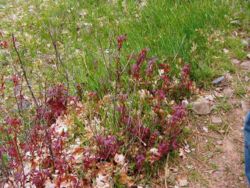Poison Oak
From Oregon Hikers Field Guide
Poison oak (Toxicodendron diversiloba) is a very common plant in our hiking area. It's often found in rocky or shallow soiled areas, often in areas with partial shade. It typically grows at all elevations below 2000 feet or so. Though it's usually found east of Cascade Locks and in southern Oregon, it will grow in wetter climates in rocky areas where the soil is well drained. After the 2017 Eagle Creek Fire, poison oak has proliferate din canopy burn areas of the western Columbia River Gorge. Shrubs can be up to eight feet tall, although many new plants are tiny. The same species also manifests itself as a climber and can reach 60 feet up a conifer! It typically has vibrant red leaves in the early spring and late fall, but the leaves are a deep green all summer. The leaves are made up of three leaflets, and this is the best way to identify it. As the saying goes, leaves of three, let them be.
Poison oak (like poison ivy in the eastern US) contains urushiol. It's an oil that causes serious allergic reactions in humans. When it soaks into your skin, a painful rash is created as your body's immune system jumps into action. The oil exists in the entire plant, and you can get the rash by touching the leaves, the stems or anything else. Burning poison oak causes the urushiol to become airborne, and you can get a rash from walking by the fire or an internal reaction from breathing the smoke. Serious inhalation can constrict your pulmonary passages. The oils can be picked up on your clothing or shoelaces only to get on your skin when you undress. Your dog can happily bring you a fresh batch of urushiol on his fur. He won't get a rash, but you will after you pet him. The oil is still active on plants that have been dead for five years.
Poison oak exposure is somewhat cumulative. The more you're exposed, the worse the effects become. Some people may be relatively immune for years then after they get a bad batch, they are extra sensitive the rest of their life. It's reported that about 15% of people are not affected by poison oak, but it should be noted that our body chemistry (and therefore our immunity) changes over our lifetime.
If you think you've got into poison oak, remove your contaminated clothes and wash your skin ASAP. Urushiol works its way into the deeper levels of the skin and bonds with proteins there and this usually takes about 15 minutes. If you're lucky enough to be that close to a shower, typical soaps are effective to remove urushiol that is on the surface of the skin. Dishwashing liquids like Dawn are particularly effective at cutting the effects of the oil. Some people recommend showering under very cold water to close the pores and reduce urushiol absorption. After the oil has bonded with your skin, there isn't a lot you can do. The rash usually shows up in 12 to 48 hours. The rash typically goes away in about two weeks, sometimes less, sometimes more, depending on the level of exposure. Calamine lotion and hydrocortisone are usually ineffective. In extreme cases, a doctor can prescribe Prednisone or Atarax, but they have side effects and should only be used under the care of a doctor and pharmacist.
One temporary, natural aid might be hot water. The concept is that the itch is caused by histimines building up in your skin. Running hot water over the affected area for a minute to a minute and a half allows that histamine to be released resulting in temporary relief. The water should be as hot as you can comfortably tolerate, but never from a stove. The itching will first grow even worse under the water, but then it lessens. The itch will be back in 5-8 hours.
Two commonly recommended products for relief are Zanfel and Tecnu. Tecnu is a strong skin cleanser that removes urushiol from the surface of the skin. Zanfel is advertised to be capable of removing urushiol even after the oil has bonded to the skin.
The best (only) real solution is to avoid the stuff in the first place. Stay alert and watch out for plants that look like these!
Pictures of Poison Oak
Note:These are early spring pictures. Poison oak is not this red most of the year.
More Links
- 10 Common Poison Oak Myths - from wyeastblog.org
- Poison Ivy, Oak and Sumac Information Center
- Zanfel
- Tecnu
Contributors
- Stevefromdodge (creator)














